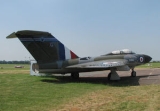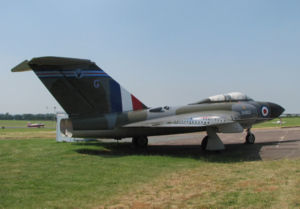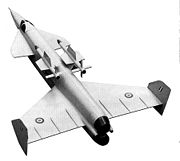
Operational Requirement F.155
Encyclopedia
Operational Requirement F.155 was a specification issued by the British Ministry of Supply for an interceptor aircraft
to defend the United Kingdom from high-flying supersonic
bomber
s.
Although a nuclear threat from Soviet
nuclear-armed bombers was identified as early as in 1955, F.155 calling for supersonic interceptors (in service by 1962) was superseded by the 1957 Defence White Paper
. The paper was a major review of military spending and one of its elements was the cancellation of nearly all manned fighter projects as a radical change had occurred in strategic threats with the expectation that intercontinental ballistic missile
s and low-level strike would replace high flying bombers.

to Gloster Javelin
all-weather fighters with the anticipation of new interceptors coming into service in the near-future. These included the English Electric Lightning
(point defence interceptor) and Saunders-Roe SR.177 interceptors in development. While the Lightning embodied largely conventional jet engine technology, the SR.177 was a "mixed" rocket/jet design that used rocket power for delivering high speed and maximum altitude performance. Due to the length of design and development, for the interim the RAF also considered purchase of the Canadian Avro CF-105 Arrow
projected to be operational by 1961.
The Ministry of Supply made clear in the requirement that the plane and missiles should be treated as a "weapon system" i.e., a cohesive whole. The armament specifications were covered by a separate Operational Requirement: OR.1131. Two missiles were identified in OR.1131:
A smaller version of Red Hebe would eventually also come into the equation. Blue Vesta was a 150 kg infra-red guided weapon for attack from a pursuit angle. The Blue Vesta was largely displaced by the development of Blue Jay Mark 4 (which would enter service as Red Top
). Red Hebe was nearly 600 kg but being radar guided, it would be able to hit its target from any firing angle including a collision course intercept.
and Rolls-Royce RB.106.
Saunders-Roe
came up with the P.187: a logical progression from the SR.53 and SR.177 mixed power (rocket and jet engines) interceptors. This gave both rapid acceleration and the capability to operate at high altitudes where jets would be inefficient due to the thin air. Saunders-Roe judged that a big aircraft would be needed to carry 2 IR and 2 radar-guided missiles and the fuel required. A highly streamlined futuristic-looking design (using a droop-nose
) it would have been powered by 2 PS.52 jets, a projected development of the Gyron giving 35,000 lb (155.6 kN) of thrust, and 4 Spectre rockets, giving a speed of Mach 2.5 at 76,000 ft (23,165 m). It was judged, at 98,000 lb (3 times the weight of the SR.177) and 84 ft (25.6 m), as too big.
 Fairey drew on their experience with the Fairey Delta 2
Fairey drew on their experience with the Fairey Delta 2
(FD2). Their first proposal was a single-engined fighter development of the existing FD2, which was felt to have good export potential although it did not meet the RAF criteria laid down in O.R. F.155. A larger twin-engined design tailored to the operational requirement followed on from this, which became known simply as the "Delta III". A fighter-bomber derivative of this aircraft was also envisaged, with Bristol Olympus 21R engines coupled with a large ventral drop tank giving a much-improved radius of action at low altitude. Fairey, like some of the other manufacturers, felt that carrying 4 missiles was too onerous especially given the size of the radar guided Red Hebe and provided designs based on a payload of only two missiles. They also took the mixed power route for both the FD2 based and the new 'FD3' designs, with both making provision for the fitting of de Havilland
rocket engines.
 Going on the basis of the smallest aircraft that could do the job, Hawker
Going on the basis of the smallest aircraft that could do the job, Hawker
's design (the P1103
) used a single, albeit powerful, engine - a 25,000 lb (111.1 kN) development of the Gyron. Alternative engines in the form of the Rolls-Royce RB.122, Armstrong-Siddeley P.173 and the Canadian
Orenda PS.13 were also options. Two detachable rocket boosters, to give a 3.7 minute boost, were carried in midwing nacelles.
 Armstrong-Whitworth put forward their AW.169. A razor-thin straight wing carried the engines in nacelles - two Gyron Juniors each side - with a rocket booster under the long narrow fuselage. Two missiles were carried, one on each wingtip.
Armstrong-Whitworth put forward their AW.169. A razor-thin straight wing carried the engines in nacelles - two Gyron Juniors each side - with a rocket booster under the long narrow fuselage. Two missiles were carried, one on each wingtip.
 Vickers-Armstrong submitted the Type 559
Vickers-Armstrong submitted the Type 559
; an unorthodox canard
design with a massive chin air intake, split vertically, for two reheated Gyron engines to 1.950k (placed as in the English Electric Lightning
, one above the other). Two Spectre Junior rockets were situated each side of the jets at wing level. Two Red Hebe or Blue Jay missiles were mounted alongside the upper part of the fuselage between the canard and the mainplane, which had end-plates incorporating twin rudders.
The AW.169 and Fairey's Delta III design were considered to be the best two contenders taking into account the design of the aircraft, the development risks, the capabilities of the design teams and the manufacturers' workloads - Bristol
had not been invited to tender because of the importance of the Bristol 188
high speed research plane they were working on. Initially further work was contracted on both designs but by the end of the year the AW.169 was dropped and the Fairey design become a firm choice. However, in April, the following year, the 1957 Defence White Paper terminated nearly all manned fighter development projects.
Interceptor aircraft
An interceptor aircraft is a type of fighter aircraft designed specifically to prevent missions of enemy aircraft, particularly bombers and reconnaissance aircraft. Interceptors generally rely on high speed and powerful armament in order to complete their mission as quickly as possible and set up...
to defend the United Kingdom from high-flying supersonic
Supersonic
Supersonic speed is a rate of travel of an object that exceeds the speed of sound . For objects traveling in dry air of a temperature of 20 °C this speed is approximately 343 m/s, 1,125 ft/s, 768 mph or 1,235 km/h. Speeds greater than five times the speed of sound are often...
bomber
Bomber
A bomber is a military aircraft designed to attack ground and sea targets, by dropping bombs on them, or – in recent years – by launching cruise missiles at them.-Classifications of bombers:...
s.
Although a nuclear threat from Soviet
Soviet Union
The Soviet Union , officially the Union of Soviet Socialist Republics , was a constitutionally socialist state that existed in Eurasia between 1922 and 1991....
nuclear-armed bombers was identified as early as in 1955, F.155 calling for supersonic interceptors (in service by 1962) was superseded by the 1957 Defence White Paper
1957 Defence White Paper
The 1957 White Paper on Defence was a British white paper setting forth the perceived future of the British military. It had profound effects on all aspects of the defence industry but probably the most affected was the British aircraft industry...
. The paper was a major review of military spending and one of its elements was the cancellation of nearly all manned fighter projects as a radical change had occurred in strategic threats with the expectation that intercontinental ballistic missile
Intercontinental ballistic missile
An intercontinental ballistic missile is a ballistic missile with a long range typically designed for nuclear weapons delivery...
s and low-level strike would replace high flying bombers.

Background
During the early 1950s, the RAF's front line defence was converting from Gloster MeteorGloster Meteor
The Gloster Meteor was the first British jet fighter and the Allies' first operational jet. It first flew in 1943 and commenced operations on 27 July 1944 with 616 Squadron of the Royal Air Force...
to Gloster Javelin
Gloster Javelin
The Gloster Javelin was an "all-weather" interceptor aircraft that served with Britain's Royal Air Force in the late 1950s and most of the 1960s...
all-weather fighters with the anticipation of new interceptors coming into service in the near-future. These included the English Electric Lightning
English Electric Lightning
The English Electric Lightning is a supersonic jet fighter aircraft of the Cold War era, noted for its great speed and unpainted natural metal exterior finish. It is the only all-British Mach 2 fighter aircraft. The aircraft was renowned for its capabilities as an interceptor; Royal Air Force ...
(point defence interceptor) and Saunders-Roe SR.177 interceptors in development. While the Lightning embodied largely conventional jet engine technology, the SR.177 was a "mixed" rocket/jet design that used rocket power for delivering high speed and maximum altitude performance. Due to the length of design and development, for the interim the RAF also considered purchase of the Canadian Avro CF-105 Arrow
CF-105 Arrow
The Avro Canada CF-105 Arrow was a delta-winged interceptor aircraft, designed and built by Avro Aircraft Limited in Malton, Ontario, Canada, as the culmination of a design study that began in 1953...
projected to be operational by 1961.
Requirement
Operation Requirement F.155 specified exacting demands:- The capability of making an intercept within 20 minutes of target contact (250 miles from the UK)
- target speed would be Mach 1+
- ceiling: 60000 ft (18,288 m)
- Armament: a mixture of infra-red guided missiles and radar guided missiles
- Crew: Two (pilot, weapons systems/navigation); a crew of two was specified because of the anticipated workload.
The Ministry of Supply made clear in the requirement that the plane and missiles should be treated as a "weapon system" i.e., a cohesive whole. The armament specifications were covered by a separate Operational Requirement: OR.1131. Two missiles were identified in OR.1131:
- Blue Vesta to be developed by de HavillandDe HavillandThe de Havilland Aircraft Company was a British aviation manufacturer founded in 1920 when Airco, of which Geoffrey de Havilland had been chief designer, was sold to BSA by the owner George Holt Thomas. De Havilland then set up a company under his name in September of that year at Stag Lane...
and - Red Hebe by Vickers, a scaled down version of their Red DeanRed DeanThe Red Dean was an air-to-air missile developed by the United Kingdom in the 1950s but cancelled before development was complete. It was a large radar-guided missile using pulse-Doppler radar against enemy bombers.-History:...
missile.
A smaller version of Red Hebe would eventually also come into the equation. Blue Vesta was a 150 kg infra-red guided weapon for attack from a pursuit angle. The Blue Vesta was largely displaced by the development of Blue Jay Mark 4 (which would enter service as Red Top
Hawker Siddeley Red Top
The Hawker Siddeley Red Top was the third indigenous British air-to-air missile to enter service, following the de Havilland Firestreak and limited-service Fairey Fireflash.-Development:...
). Red Hebe was nearly 600 kg but being radar guided, it would be able to hit its target from any firing angle including a collision course intercept.
Designs
Most British manufacturers provided their own suggestions for planes that would meet the specification. At the same time the engine manufacturers were encouraged to develop the necessary powerplants. These included the de Havilland GyronDe Havilland Gyron
|-See also:-Bibliography:* Gunston, Bill. World Encyclopedia of Aero Engines. Cambridge, England. Patrick Stephens Limited, 1989. ISBN 1-85260-163-9-External links:** - A 1957 Flight magazine article on the Gyron...
and Rolls-Royce RB.106.
Saunders-Roe
Saunders-Roe
Saunders-Roe Limited was a British aero- and marine-engineering company based at Columbine Works East Cowes, Isle of Wight.-History:The name was adopted in 1929 after Alliot Verdon Roe and John Lord took a controlling interest in the boat-builders S.E. Saunders...
came up with the P.187: a logical progression from the SR.53 and SR.177 mixed power (rocket and jet engines) interceptors. This gave both rapid acceleration and the capability to operate at high altitudes where jets would be inefficient due to the thin air. Saunders-Roe judged that a big aircraft would be needed to carry 2 IR and 2 radar-guided missiles and the fuel required. A highly streamlined futuristic-looking design (using a droop-nose
Droop-nose
The Droop Nose was a distinctive feature of both Concorde, the Moxon and the Tu-144. When these aircraft were in service, the pilot would lower the nose to improve visibility of the runway and taxiways. When in flight, the nose would be raised. Concorde also had a moving visor that would slide into...
) it would have been powered by 2 PS.52 jets, a projected development of the Gyron giving 35,000 lb (155.6 kN) of thrust, and 4 Spectre rockets, giving a speed of Mach 2.5 at 76,000 ft (23,165 m). It was judged, at 98,000 lb (3 times the weight of the SR.177) and 84 ft (25.6 m), as too big.

Fairey Delta 2
The Fairey Delta 2 or FD2 was a British supersonic research aircraft produced by the Fairey Aviation Company in response to a specification from the Ministry of Supply for investigation into flight and control at transonic and supersonic speeds.The aircraft was the first to exceed 1000mph, and...
(FD2). Their first proposal was a single-engined fighter development of the existing FD2, which was felt to have good export potential although it did not meet the RAF criteria laid down in O.R. F.155. A larger twin-engined design tailored to the operational requirement followed on from this, which became known simply as the "Delta III". A fighter-bomber derivative of this aircraft was also envisaged, with Bristol Olympus 21R engines coupled with a large ventral drop tank giving a much-improved radius of action at low altitude. Fairey, like some of the other manufacturers, felt that carrying 4 missiles was too onerous especially given the size of the radar guided Red Hebe and provided designs based on a payload of only two missiles. They also took the mixed power route for both the FD2 based and the new 'FD3' designs, with both making provision for the fitting of de Havilland
De Havilland
The de Havilland Aircraft Company was a British aviation manufacturer founded in 1920 when Airco, of which Geoffrey de Havilland had been chief designer, was sold to BSA by the owner George Holt Thomas. De Havilland then set up a company under his name in September of that year at Stag Lane...
rocket engines.

Hawker Aircraft
Hawker Aircraft Limited was a British aircraft manufacturer responsible for some of the most famous products in British aviation history.-History:...
's design (the P1103
Hawker P.1103
The Hawker P.1103 was a design by Hawker Aircraft to meet the British Operational Requirement F.155; it was not developed into an aircraft.-Background:...
) used a single, albeit powerful, engine - a 25,000 lb (111.1 kN) development of the Gyron. Alternative engines in the form of the Rolls-Royce RB.122, Armstrong-Siddeley P.173 and the Canadian
Canada
Canada is a North American country consisting of ten provinces and three territories. Located in the northern part of the continent, it extends from the Atlantic Ocean in the east to the Pacific Ocean in the west, and northward into the Arctic Ocean...
Orenda PS.13 were also options. Two detachable rocket boosters, to give a 3.7 minute boost, were carried in midwing nacelles.


Vickers Type 559
-References:* Andrews, C.F. and E.B. Morgan. Supermarine Aircraft since 1914. London:Putnam, 1987. ISBN 0 85177 800 3.* Butler, Tony. "Futile Rivals: F.155T - The Quest for "An Ultimate in Interceptors"". Air Enthusiast, No. 61, January/February 1996. Stamford, UK:Key Publishing. ISSN 0143 5450....
; an unorthodox canard
Canard (aeronautics)
In aeronautics, canard is an airframe configuration of fixed-wing aircraft in which the forward surface is smaller than the rearward, the former being known as the "canard", while the latter is the main wing...
design with a massive chin air intake, split vertically, for two reheated Gyron engines to 1.950k (placed as in the English Electric Lightning
English Electric Lightning
The English Electric Lightning is a supersonic jet fighter aircraft of the Cold War era, noted for its great speed and unpainted natural metal exterior finish. It is the only all-British Mach 2 fighter aircraft. The aircraft was renowned for its capabilities as an interceptor; Royal Air Force ...
, one above the other). Two Spectre Junior rockets were situated each side of the jets at wing level. Two Red Hebe or Blue Jay missiles were mounted alongside the upper part of the fuselage between the canard and the mainplane, which had end-plates incorporating twin rudders.
The AW.169 and Fairey's Delta III design were considered to be the best two contenders taking into account the design of the aircraft, the development risks, the capabilities of the design teams and the manufacturers' workloads - Bristol
Bristol Aeroplane Company
The Bristol Aeroplane Company, originally the British and Colonial Aeroplane Company, was both one of the first and one of the most important British aviation companies, designing and manufacturing both airframes and aero engines...
had not been invited to tender because of the importance of the Bristol 188
Bristol 188
The Bristol 188 was a British supersonic research aircraft built by the Bristol Aeroplane Company in the 1950s. Its length, slender cross-section and intended purpose led to its being nicknamed the "Flaming Pencil".-Design and development:...
high speed research plane they were working on. Initially further work was contracted on both designs but by the end of the year the AW.169 was dropped and the Fairey design become a firm choice. However, in April, the following year, the 1957 Defence White Paper terminated nearly all manned fighter development projects.

